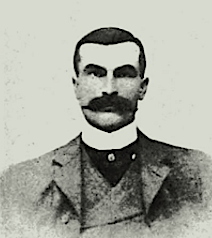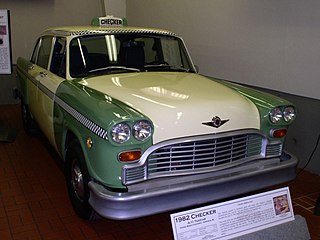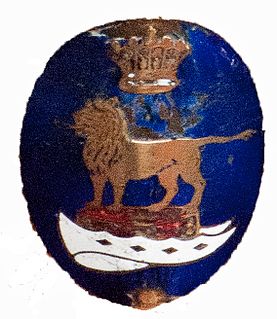
D. Napier & Son Limited was a British engineering company best known for its luxury motor cars in the Edwardian era and for its aero engines throughout the early to mid-20th century.

A hackney or hackney carriage is a carriage or car for hire. A hackney of a more expensive or high class was called a remise.

Panhard was a French motor vehicle manufacturer that began as one of the first makers of automobiles. It was a manufacturer of light tactical and military vehicles. Its final incarnation, now owned by Renault Trucks Defense, was formed by the acquisition of Panhard by Auverland in 2005, and then by Renault in 2012. In 2018 Renault Trucks Defense, ACMAT and Panhard combined under a single brand, Arquus.

Checker Motors Corporation was a Kalamazoo, Michigan, vehicle manufacturer and tier-one subcontractor that manufactured taxicabs used by Checker Taxi. Checker Motors Corporation was established by Morris Markin in 1922 through a merger of Commonwealth Motors and Markin Automobile Body.

The Yellow Cab Company was a taxicab company in Chicago which was founded in 1907 by John D. Hertz.

Sunbeam Motor Car Company Limited was a British motor car manufacturer with its works at Moorfields in Blakenhall, a suburb of Wolverhampton in the county of Staffordshire, now West Midlands. Its Sunbeam name had been registered by John Marston in 1888 for his bicycle manufacturing business. Sunbeam motor car manufacture began in 1901. The motor business was sold to a newly incorporated Sunbeam Motor Car Company Limited in 1905 to separate it from Marston's pedal bicycle business; Sunbeam motorcycles were not made until 1912.

A landaulet, also known as a landaulette, is a car body style where the rear passengers are covered by a convertible top. Often the driver is separated from the rear passengers by a division, as with a limousine.

Selwyn Francis Edge (1868–1940) was a British businessman, racing driver, cyclist and record-breaker. He is principally associated with selling and racing De Dion-Bouton, Gladiator; Clemént-Panhard, Napier and AC cars.
Taxicabs in a single country often share a set of common properties, but there is a wide variation from country to country in the vehicles used, the circumstances under which they may be hired and the regulatory regime to which these are subject.
The taxicabs of the United States make up a mature system; most U.S. cities have a licensing scheme which restricts the number of taxicabs allowed. As of 2012, in the United States: the total number of taxi cab drivers is 233,900; the average annual salary of a taxi cab driver is $22,820; the expected percent job increase over the next 10 years is 16%.

A taxi, also known as a cab or a taxicab, is a type of vehicle for hire with a driver, used by a single passenger or small group of passengers, often for a non-shared ride. A taxicab conveys passengers between locations of their choice. This differs from public transport where the pick-up and drop-off locations are decided by the service provider, not by the customers, although demand responsive transport and share taxis provide a hybrid bus/taxi mode.

Gustave Adolphe Clément, from 1909 Clément-Bayard, was a French entrepreneur. An orphan who became a blacksmith and a Compagnon du Tour de France, he went on to race and manufacture bicycles, pneumatic tyres, motorcycles, automobiles, aeroplanes and airships.
A Darracq and Company Limited owned a French manufacturer of motor vehicles and aero engines in Suresnes, near Paris. The French enterprise, known at first as A. Darracq et Cie, was founded in 1896 by Alexandre Darracq after he sold his Gladiator Bicycle business. In 1902, it took effect in 1903, he sold his new business to a privately held English company named A Darracq and Company Limited, taking a substantial shareholding and a directorship himself.

Checker Taxi was a dominant taxicab company and national franchisor that was based in Chicago, Illinois. Checker Motors was an American car company. Both companies were owned by Morris Markin by the 1930s.
Montague Stanley Napier was an English automobile and aircraft engine manufacturer. His grandfather, David Napier (1785–1873), had moved to London from Scotland and by 1836 had established an engineering company in Lambeth called D. Napier & Son. Montague Napier bought the business from the executors of his father's estate in 1895, and diversified into producing machine tools for the cycle industry.

Clément-Talbot Limited was a British motor vehicle manufacturer with its works in Ladbroke Grove, North Kensington, London, founded in 1902. Rootes renamed it Sunbeam-Talbot Limited in 1938.

Charles Jarrott was an English racing car driver and businessman. Jarrott raced from 1900 to 1904, winning the 1902 Circuit des Ardennes race and competing in the 1903 and 1904 Gordon Bennett Cup races. He was the chair of the Motor Cycling Club's Annual Dinner at the Trocadero on Saturday 12 December 1913. He co-founded a car import firm in 1902 and was a founder member of the Automobile Association, serving as chairman in 1922.

Mann & Overton Limited owned and operated a motor vehicle dealers business previously known as Mann & Overton's and established 14 May 1901 which came to specialise in the supply and financing of London taxicabs, first Unic then Austin Taxicabs, eventually holding the concession for the Austin taxicab chassis for the whole of the Metropolitan Police Area of London.
Darracq Motor Engineering Company Limited was a London importer, retailer and wholesaler of French-made Darracq and Talbot automobiles, a coachbuilder making regular production runs of bodies for S T D group products and a property holding company on behalf of its parent S T D Motors Limited.

Automobiles Darracq France was a manufacturer of motor vehicles and aero engines in Suresnes, near Paris. The enterprise, known at first as A Darracq et Cie, was founded in 1896 by successful businessman Alexandre Darracq.

















